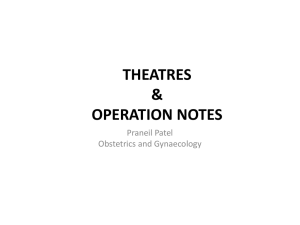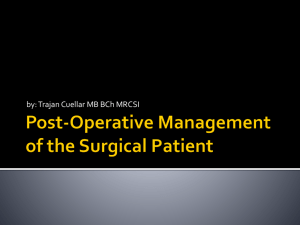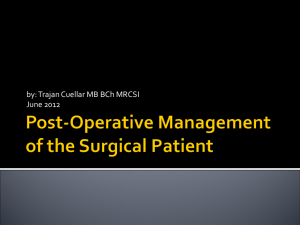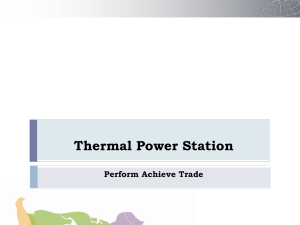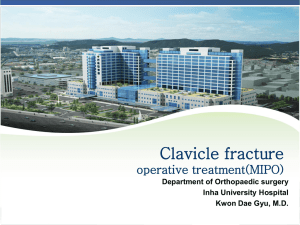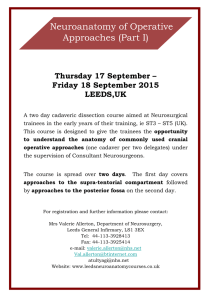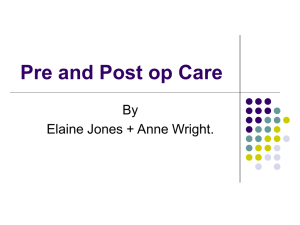About this Unit
advertisement
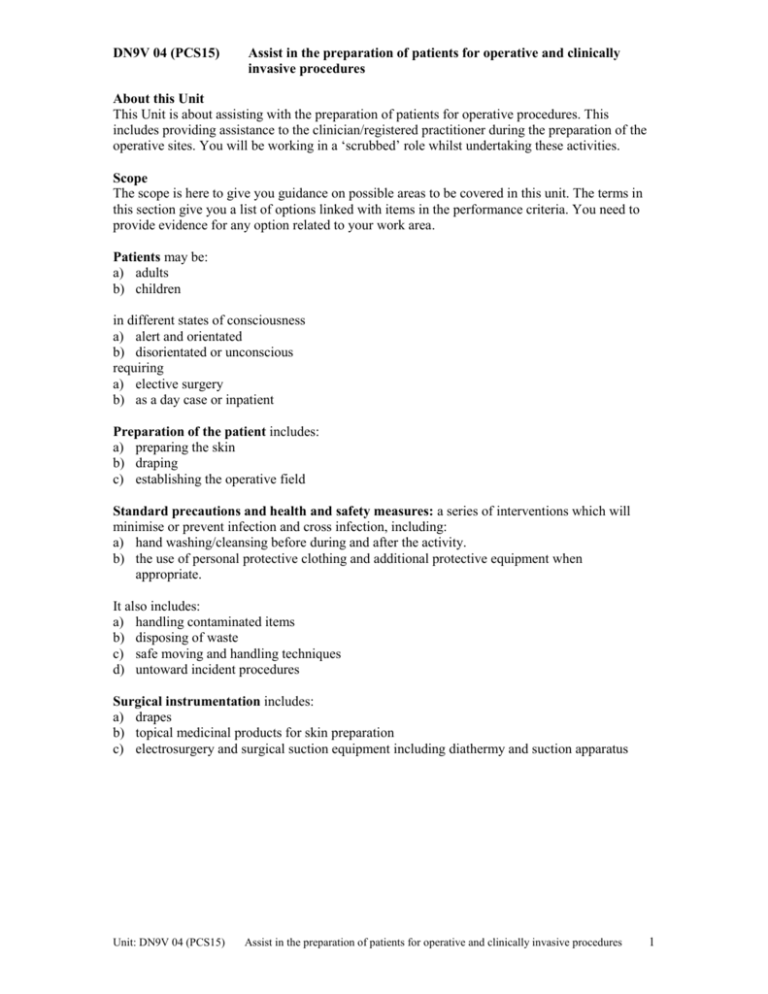
DN9V 04 (PCS15) Assist in the preparation of patients for operative and clinically invasive procedures About this Unit This Unit is about assisting with the preparation of patients for operative procedures. This includes providing assistance to the clinician/registered practitioner during the preparation of the operative sites. You will be working in a ‘scrubbed’ role whilst undertaking these activities. Scope The scope is here to give you guidance on possible areas to be covered in this unit. The terms in this section give you a list of options linked with items in the performance criteria. You need to provide evidence for any option related to your work area. Patients may be: a) adults b) children in different states of consciousness a) alert and orientated b) disorientated or unconscious requiring a) elective surgery b) as a day case or inpatient Preparation of the patient includes: a) preparing the skin b) draping c) establishing the operative field Standard precautions and health and safety measures: a series of interventions which will minimise or prevent infection and cross infection, including: a) hand washing/cleansing before during and after the activity. b) the use of personal protective clothing and additional protective equipment when appropriate. It also includes: a) handling contaminated items b) disposing of waste c) safe moving and handling techniques d) untoward incident procedures Surgical instrumentation includes: a) drapes b) topical medicinal products for skin preparation c) electrosurgery and surgical suction equipment including diathermy and suction apparatus Unit: DN9V 04 (PCS15) Assist in the preparation of patients for operative and clinically invasive procedures 1 DN9V 04 (PCS15) Assist in the preparation of patients for operative and clinically invasive procedures Key words and concepts Additional protective equipment Contaminated Elective Surgery National Guidelines Personal protective clothing Potential sources of contamination Sterile field Unit: DN9V 04 (PCS15) Includes types of personal protective equipment such as visors, protective eyewear and radiation protective equipment Includes items ‘contaminated’ with body fluids, chemicals or radionuclides. Any pack/item opened and not used should be treated as contaminated Surgery which is not needed immediately, i.e. one for a non-life threatening disorder Includes current approved national/benchmarked guidelines Includes items such as plastic aprons, gloves – both clean and sterile, footwear, dresses, trousers and shirts and all in one trouser suits. These may be single use disposable clothing or reusable clothing Includes dirty skin, urine/faeces or other bodily fluids An area that is aseptic, free from living microorganisms Assist in the preparation of patients for operative and clinically invasive procedures 2 DN9V 04 (PCS15) Assist in the preparation of patients for operative and clinically invasive procedures Specific Evidence Requirements for this Unit Simulation: Simulation is NOT permitted for any part of this Unit. The following forms of evidence are mandatory: Direct Observation: Your assessor or an expert witness must observe you in real work activities which provide evidence for a significant amount of the performance criteria for this unit. Reflective Account/professional discussion: You describe your actions in a particular situation(s) and reflection on the reason(s) for you practicing in that way. Competence of performance and knowledge could also be demonstrated using a variety of evidence from the following: Questioning/professional discussion: May be used to provide evidence of knowledge, legislation, policies and procedures which cannot be fully evidenced through direct observation or reflective accounts. In addition the assessor/expert witness may also ask questions to clarify aspects of your practice. Expert Witness: A designated expert witness (for example nurse, doctor, ODP) may provide direct observation of practice, questioning, professional discussion and feedback on reflective accounts. Witness Testimony: Can be a confirmation or authentication of the activities described in your evidence which your assessor has not seen. This could be provided by a work colleague. Products: These can be any record that you would normally use within your normal role e.g. policies and procedures and reports and records, etc. You need not put confidential records in your portfolio, they can remain where they are normally stored and be checked by your assessor and internal verifier. If you do include them in your portfolio all names and identifying information must be removed to ensure confidentiality. General guidance Prior to commencing this unit you should agree and complete an assessment plan with your assessor which details the assessment methods you will be using, and the tasks you will be undertaking to demonstrate your competence. Evidence must be provided for ALL of the performance criteria ALL of the knowledge and the parts of the scope that are relevant to your job role. The evidence must reflect the policies and procedures of your workplace and be linked to current legislation, values and the principles of best practice within the Perioperative setting. This will include the National Service Standards and/or KSF for your areas of work and the individuals you care for. All evidence must relate to your own work practice. Unit: DN9V 04 (PCS15) Assist in the preparation of patients for operative and clinically invasive procedures 3 DN9V 04 (PCS15) Assist in the preparation of patients for operative and clinically invasive procedures KNOWLEDGE SPECIFICATION FOR THIS UNIT Competent practice is a combination of the application of skills and knowledge informed by values and ethics. This specification details the knowledge and understanding required to carry out competent practice in the performance described in this Unit. When using this specification it is important to read the knowledge requirements in relation to expectations and requirements of your job role. You need to provide evidence for all knowledge points listed below. There are a variety of ways this can be achieved so it is essential that you read the ‘knowledge evidence’ section of the Assessment Guidance. You need to show that you know, understand and can apply in practice: Enter Evidence Numbers Legislation, policy and good practice 1 A factual awareness of the current European and national legislation, national guidelines, local policies and protocols which affect your work practice in relation to preparing patients for surgical procedures 2 A working understanding of your responsibilities and accountability in relation to the current European and national legislation, national guidelines and local policies and protocols within the perioperative care environment 3 A factual awareness of the importance of working within your own sphere of competence and seeking advice when faced with situations outside your sphere of competence 4 A working understanding of the application of standard precautions to the preparation of patients for operative procedures and the potential consequences of poor practice Clinical materials and equipment 5 A working understanding of the types, purpose and function of surgical instrumentation and supplementary items used in patient preparation for surgery 6 A working understanding of factors which affect the choice of surgical instrumentation and supplementary items for individual patients 7 A working understanding of factors which affect the choice of appropriate sites for attaching instrumentation, e.g. diathermy, during patient preparation 8 A working understanding of common skin preparation agents and their: a) presentation and nomenclature b) mode of action c) precautions required to prevent allergic reactions and diathermy burns 9 A working understanding of the types of surgical drape in common use, and the effectiveness of different types of material as barriers to cross infection 10 A working understanding of the dangers of re-using equipment designed for single use only Unit: DN9V 04 (PCS15) Assist in the preparation of patients for operative and clinically invasive procedures 4 DN9V 04 (PCS15) Assist in the preparation of patients for operative and clinically invasive procedures You need to show that you know, understand and can apply in practice: Enter Evidence Numbers Operative procedures and techniques 11 A working understanding of the relationships between effective surgical field preparation, prevention of wound contamination and surgical access 12 A working understanding of specific instances where particular, nonroutine methods are used to prepare the surgical field (on the ward and in the operating department), and the rationale for this 13 A working understanding of safe and effective methods of applying skin preparation agents and the type and extent of skin preparation needed Team and organisation structures and systems 14 A working understanding of the specific lines of accountability within the surgical team Records and documentation 15 A working understanding of the information which should be recorded in relation to the preparation of patients for operative procedures 16 A working understanding of the importance of recording information relating to the preparation of patients for operative procedures 17 A working understanding of the importance of immediately reporting any issues which are outside your own sphere of competence without delay to the relevant member of staff Unit: DN9V 04 (PCS15) Assist in the preparation of patients for operative and clinically invasive procedures 5 DN9V 04 (PCS15) Assist in the preparation of patients for operative and clinically invasive procedures Performance Criteria 1 Apply standard precautions for infection control and other relevant health and safety measures 2 Assist in the preparation of the patient in a manner which optimises their dignity, comfort and safety 3 Correctly identify potential sources of contamination and take appropriate action to minimise any risks. 4 Correctly identify the patient’s operative site, and clarify and uncertainties with the registered practitioner before assisting with the preparation 5 Correctly select and handle surgical instrumentation and supplementary items in line with manufacturers’ instructions and in a manner which minimises the risk of harm. 6 Ensure all swabs and items used in the preparation of the operative site are accounted for and recorded in accordance with national guidelines prior to safe disposal 7 Select and appropriate site on the sterile field for attaching surgical instruments and supplementary items 8 Ensure safe and correct disposal of waste associated with surgical preparation Unit: DN9V 04 (PCS15) DO RA EW Q P Assist in the preparation of patients for operative and clinically invasive procedures WT 6 DN9V 04 (PCS15) Assist in the preparation of patients for operative and clinically invasive procedures To be completed by the Candidate I SUBMIT THIS AS A COMPLETE UNIT Candidate’s name: …………………………………………… Candidate’s signature: ……………………………………….. Date: ………………………………………………………….. To be completed by the Assessor It is a shared responsibility of both the candidate and assessor to claim evidence, however, it is the responsibility of the assessor to ensure the accuracy/validity of each evidence claim and make the final decision. I CERTIFY THAT SUFFICIENT EVIDENCE HAS BEEN PRODUCED TO MEET ALL THE ELEMENTS, PCS AND KNOWLEDGE OF THIS UNIT. Assessor’s name: ……………………………………………. Assessor’s signature: ……………………………………….... Date: ………………………………………………………….. Assessor/Internal Verifier Feedback To be completed by the Internal Verifier if applicable This section only needs to be completed if the Unit is sampled by the Internal Verifier Internal Verifier’s name: …………………………………………… Internal Verifier’s signature: ……………………………………….. Date: ……………………………………..………………………….. Unit: DN9V 04 (PCS15) Assist in the preparation of patients for operative and clinically invasive procedures 7

